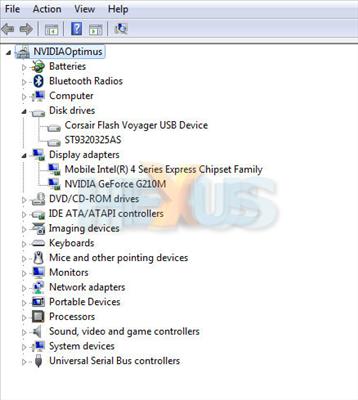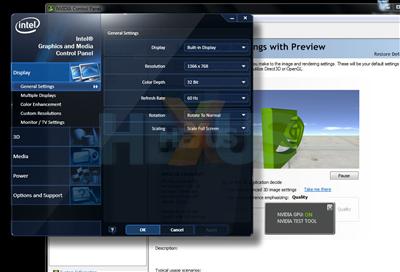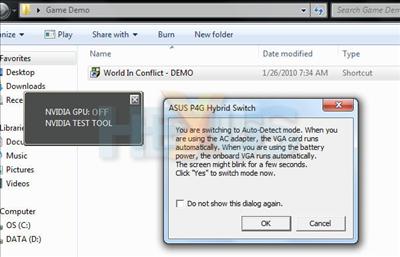We have a play
Here's the Optimus-totin' ASUS UL50VF laptop supplied by NVIDIA for demonstration purposes. On top of the Optimus technology, it packs in a dual-core Core 2 Duo ULV U7300 chip, GeForce G210M 512MB mobile graphics card, X4500 integrated graphics, and a 15.6in screen with a native resolution of 1,366x768 pixels. Costing around £700, it is representative of a mainstream notebook with premium graphics.
A peek at the Device Manager shows both the integrated graphics and mGPU GeForce G210M coexisting. Optimus works by having both drives in situ.
One can pull up both the IGP and mGPU's control panels concurrently. NVIDIA includes a reviewer's tool that defines the current state of the mGPU. It is always on when plugged into the mains and on high-performance mode, but the default situation is off when in any other state, unless modified by the user. Of course, the mGPU is active when interrogating the NVIDIA control panel.
When placed in battery mode and with the notebook set to 'balanced' the GPU is always off.
But load up an application that makes a call to the mGPU or is flagged by the Optimus routing layer and on it flicks. The process is completely transparent to the user - there are no flickers or any indication that the mGPU has been activated.
The GeForce G210M mGPU switches on when playing a game. Interestingly when loading the World In Conflict Demo, before the game's screen becomes active, the mGPU is constantly switched on and off as the technology tries to assess whether it is needed or not. Once the game has been exited, ASUS' built-in Switchable Graphics wants to take over, but Optimus has already switched the card off.
We spoke about the somewhat arbitrary method that's used to enable the mGPU. It doesn't come on when running 1080p video in the .wmv format, leaving the work to the CPU and onboard IGP. But you can always add a profile to ensure that the GPU takes up the processing.
As shipped, it wakes up as some 1080p H.264-encoded content is thrown its way, just as it should do for any PureVideo-based card..
Understanding Optimus is simple, then. It comes on when called and switches the mGPU off when not required.










